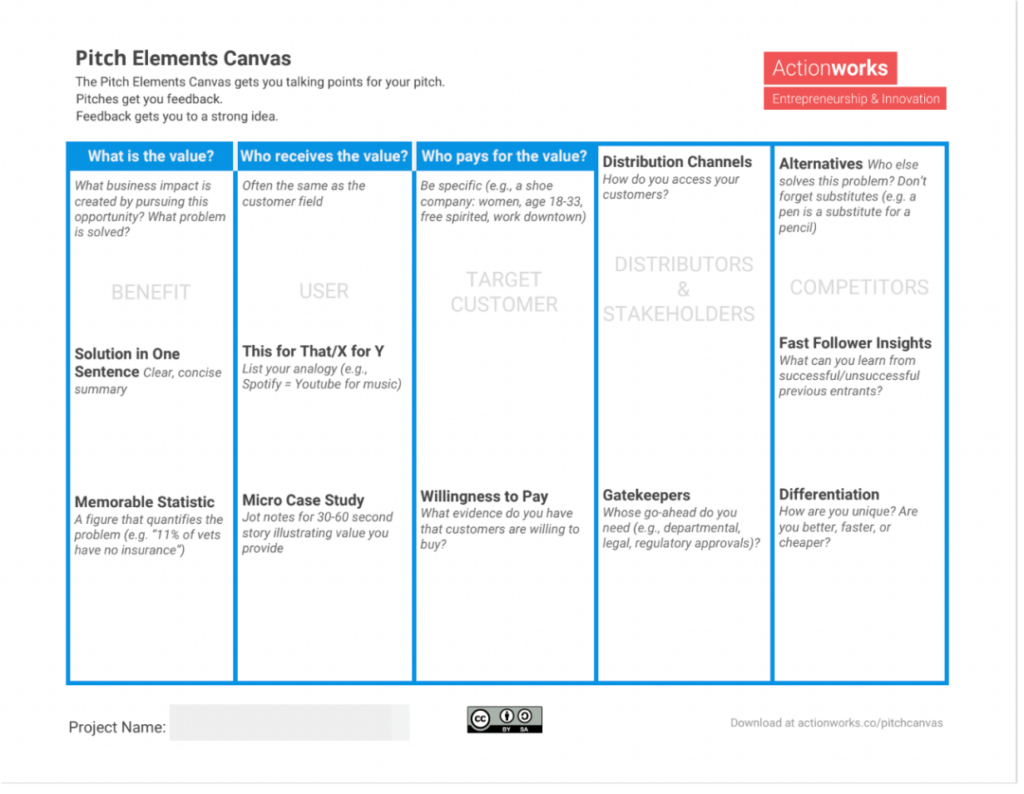Find the talking points for your idea
How many of your ideas fail to resonate with a…
- customer
- investor
- stakeholder
…simply by virtue of how the words came out, rather than the merits of the idea itself? How many ideas fail to gain traction because of the way the idea was expressed?

The Pitch Elements Canvas helps you surface talking points for how you articulate an idea. These talking points equip you to advocate (and more importantly, get feedback on) your idea with others. The more people you tell, the more feedback you receive, which helps you iterate to a stronger pitch.
How to use the Pitch Elements Canvas
- Quickly: On your first pass, blaze through completing the canvas. Think stream of consciousness, not overanalysis. Some boxes will come easier than others. Use the insights generated from this process when you talk about your ideas.
- Iteratively: When you tell people about your idea, note how they react to your talking points. Some audience will have a spark in their eyes; others will glaze over. Use this feedback to test new talking points. Your “completed” canvas will look drastically different at different phases of execution.
Value: What value is created by pursuing this opportunity or alleviating this problem?
The first three prompts of the canvas focus on value, which we will define as the benefit your idea generates. Value is an important concept (as opposed to over-focusing on a problem) because so many innovations ranging from the automobile to the post-it note weren’t directly focused on solving an existing problem. Rather, they solved problems that people did not know they had.
The canvas poses three foundational questions and clarifies customers vs. users:
- What is the value? (benefit)
- Who receives the value? (user)
- Who pays for the value? (customer)
If your idea is not creating value for someone, it is probably not a good idea.


Solution in One Sentence
This prompt is a forcing function. Most people to whom you are presenting do not have time to hear a long, drawn out spiel. They need to hear your idea in a concise form to quickly decide if they want to hear more, i.e. if your idea is relevant to them.
Memorable Statistic
We are all influenced by stats and figures and this box forces you to find a compelling number to support the claim behind your idea, and remind your audience that your idea matters.
This for That/X for Y
Ridley Scott secured funding for Alien, his most famous film, by pitching it as “Jaws in Space.” This style of pitch is incredibly efficient: in three words, he was able to suggest that his film would achieve Jaws-like success: critical acclaim, extremely financially rewarding, and positioned for bankable sequels.
If you describe your idea as “instagram for [x]”, your idea immediately becomes easier to understand and it establishes positive associations.
Micro Case Study
A short, digestible story complements the previous boxes by allowing you to show (rather than tell) your idea. Note that the story does not need to describe what your solution does. Simply describing drawbacks with how a problem is currently solved in story form is useful.


Willingness to Pay
What evidence do you have that customers are willing to pay for your solution? The true test of willingness to pay is to do real selling, but this box forces you to think more deeply about it.
Distribution Channels
How do you access your customers? How do you reach them? As it gets easier and easier sell goods and services on the internet, the landscape gets more crowded, which means that distribution matters more and more. Thinking about customer acquisition channels early is helpful.
Gatekeepers
What individuals or groups do you need approval from to be successful? This need varies from industry to industry. Is it Alice from accounting? Is it Bob in the marketing department? Is it the FDA? Is it the state accreditation board?
Alternatives
Who else solves the same problem? Don’t forget substitutes. For example, a pen is a different product category than a pencil but solves the same problem (writing).
Fast Follower Insights
First mover advantage is overrated and the first company to pursue an opportunity is often like the lead cyclist in a race: the first rider receives all of the wind resistance and cannot learn from others who have covered the ground earlier.
This prompt urges you to research previous attempts? What can you learn from them?
Differentiation
How are you different from other offerings (i.e., the product or service) and companies (i.e., the organizational and operating structures of other players)?
The best pitches are the product of numerous cycles of feedback. This tool provides a structured process to develop ideas to receive feedback.